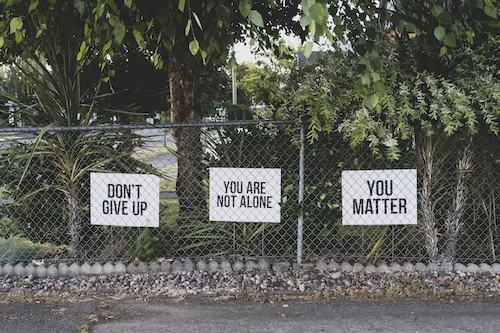Current statistics on suicide in the United States are staggering. Suicide is the 12th leading cause of death in the country. In 2020, the number of Americans who died by suicide was almost 46,000. There were an additional 1.2M suicide attempts in the nation. While the highest rate of suicide was determined to be in adults aged 85 and older, higher suicide rates also existed among adults ages 25-34, the age of much of today’s workforce. The survey also concluded that 93% of Americans believe suicide can be prevented.
September is National Suicide Prevention Month so it has me thinking about how those that believe suicide is preventable can actually contribute to its prevention. As an HR professional, I am always thinking about how we can continue to improve the employee experience for our workforce. The recent pandemic really brought to the forefront the importance of recognizing and supporting the total wellbeing of ourselves and others.
Think about it….stress comes disguised as a hitchhiker on the heels of many other human conditions such as poor physical health, chronic illness, mental fragility, financial vulnerability, and the challenges of parenthood, just to name a few. The one thing all of these have in common is that they have the propensity to degrade mental wellbeing if not properly addressed or managed. Everyone has a role to play to save lives and create healthy and strong individuals, families, and communities. As employers, we should be committed to providing safe and healthy workplaces that promote effective work-life integration and job satisfaction through support of broad and creative HR programs and resources.
Forty-six percent of suicide victims have a mental health condition. This telling statistic highlights the importance of offering a mental health wellness benefit as part of today’s employee benefits package. An employee assistance program (EAP) can be a valuable resource for employees who might not otherwise reach out for help. EAP’s are designed to assist employees with personal or work-related problems that may impact their job performance, health, mental and emotional wellbeing. There are many companies who offer lots of EAP options, some more robust and expensive than others. In my opinion, price is less of a consideration if it means improving the employee experience, strengthening the employee-employer relationship, and, most importantly, providing a true lifeline for someone in need.
While EAP’s are one of the most well-known employer options in support of employee mental health, there are a host of other ways to create and/or maintain a company culture who prioritizes total employee wellbeing.
- Communication is the key to the success of any program, relationship, or transaction. It isn’t enough to just put the information out there. We must present it with clarity and sincerity, explain its origin and intent, and share how it will benefit not only the individual stakeholders but the organization as a whole.
- Modify policies and practices to allow for flexibility. Take a look at your paid time off and other leave policies and determine if they can be enhanced to promote better work-life integration and possibly improve performance and productivity as well.
- Beef up your training curriculum. Include topics on wellbeing such as self-care, stress management, and financial wellness. Host lunch-and-learn opportunities for your employees with professionals such as nutritionists or financial planners.
- Model healthy behaviors. Organizational leaders should “practice what they preach”. It’s an old but true adage. Employees look at their leaders as role models - examples of what to do and what not to do, the exemplification of how to succeed at work. Ensure your behaviors are encouraging rather than discouraging self-preservation. Are you taking time off to rest and recharge? Are you managing your own physical health by committing to preventive maintenance appointments and routines? Are you sharing stories of how you relieve stress or what works for you when life’s demands are overwhelming? It’s important to remind ourselves that we are only human, and we can only care for others if we’re caring for ourselves, too.
I encourage you to explore the current state of wellbeing in your organization. Talk about it, promote the company’s philosophy about it (if you don’t have one, develop one), find out what’s important to your workforce. Don’t ignore it. Mental wellbeing affects everyone. Knowing there is a support system and having confidence in using it can be lifesaving benefits. Whether you choose to engage with an EAP provider, update your training content, and/or employ one of the many other wellbeing opportunities out there, be part of the 93% who believe suicide is preventable and save a life!
The 988 Suicide & Crisis Lifeline provides 24/7, free and confidential support for people in distress across the U.S. This national network is committed to improving crisis services and aiding in suicide prevention by empowering individuals, advancing professional best practices, and building awareness.
Rema Gray has a lifelong interest in relationship management and a deep curiosity for human behavior in the workplace, Rema Gray began her payroll and HR career over 25 years ago. She pursued a degree in Psychology from the University of South Alabama and parlayed her education and training into a Human Resource Management career. Her experience ranges from managing the intricacies of human capital growth and development of small local businesses to developing teams and managers for large national corporations. She has worked in many industries, including chemical plants and oil refineries, business services, retail, and many other spaces. She currently manages HR for Crescent Payroll Solutions, contributing to the creation of policies and procedures, measuring and managing organizational risk, organizing, training, and development of the operations team, and maintaining a high level of employee engagement. Rema’s passion is getting everyone in the proverbial boat rowing in the same direction. She believes employee commitment to the organization’s Mission, Vision, and Values is not only essential to the achievement of its goals but also paramount to the overall health and sustainability of the organization itself.
“Human Resources is a basic term to describe a dynamic topic. Focusing on the human part of it is integral to the success of any employee-based business.”



